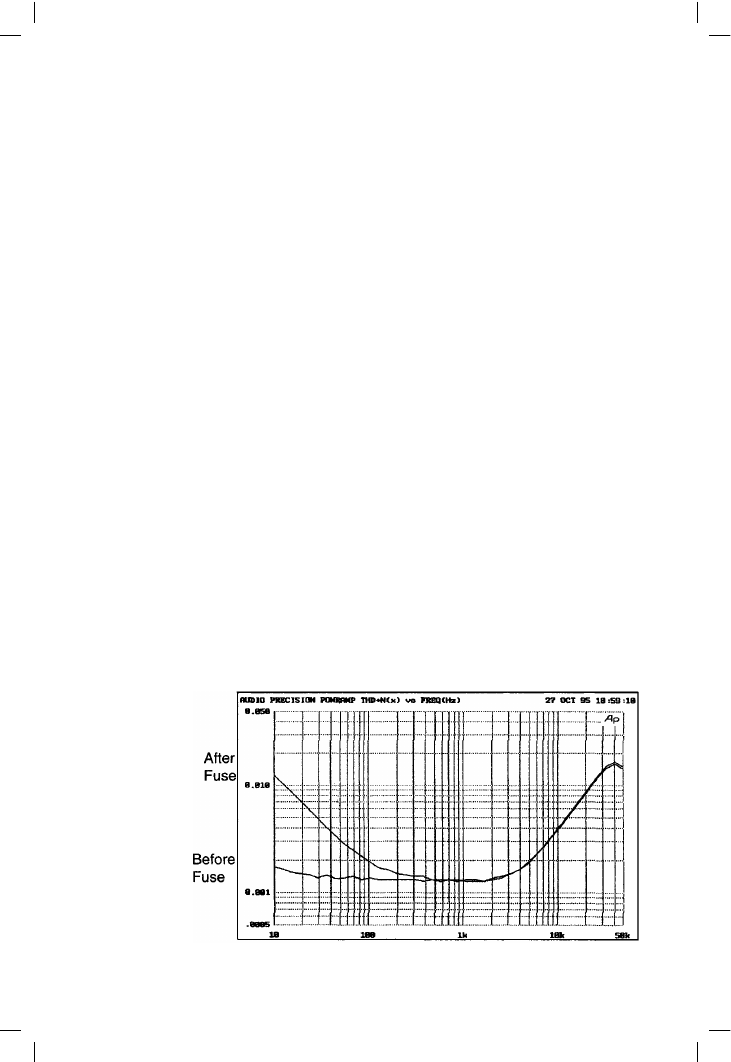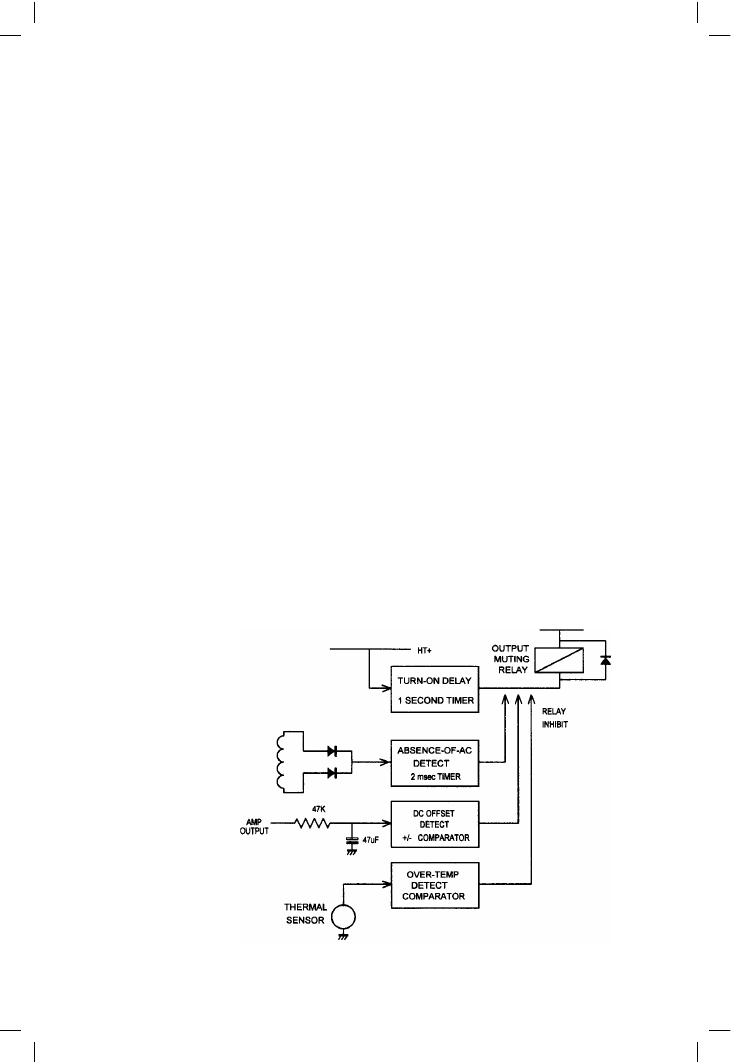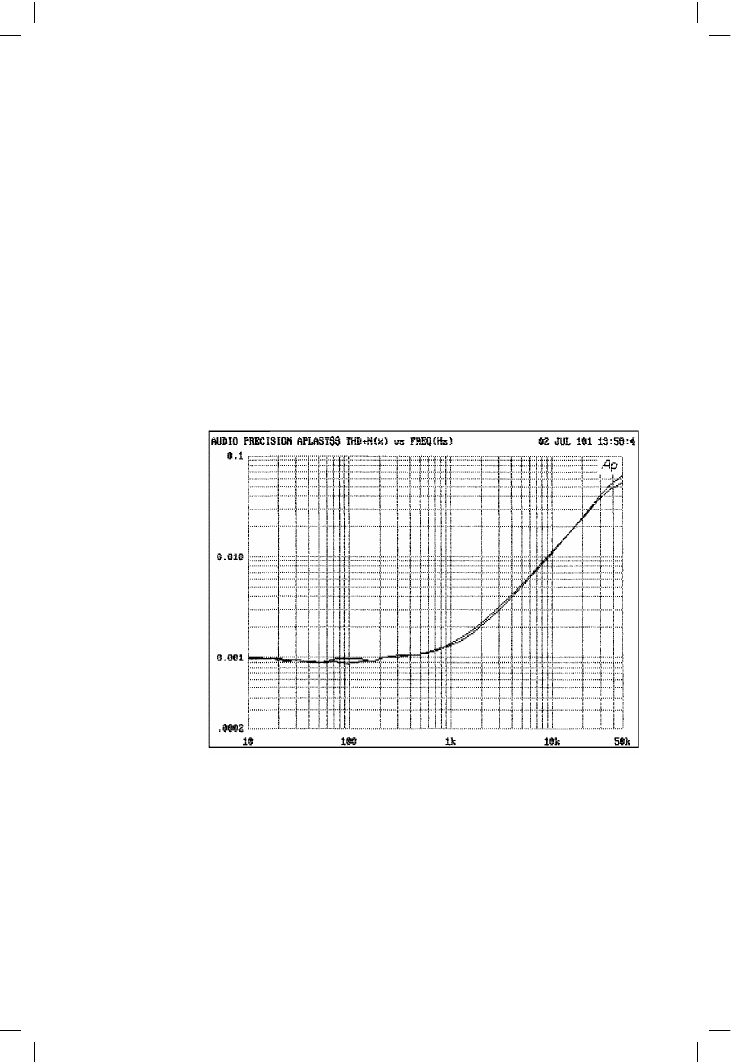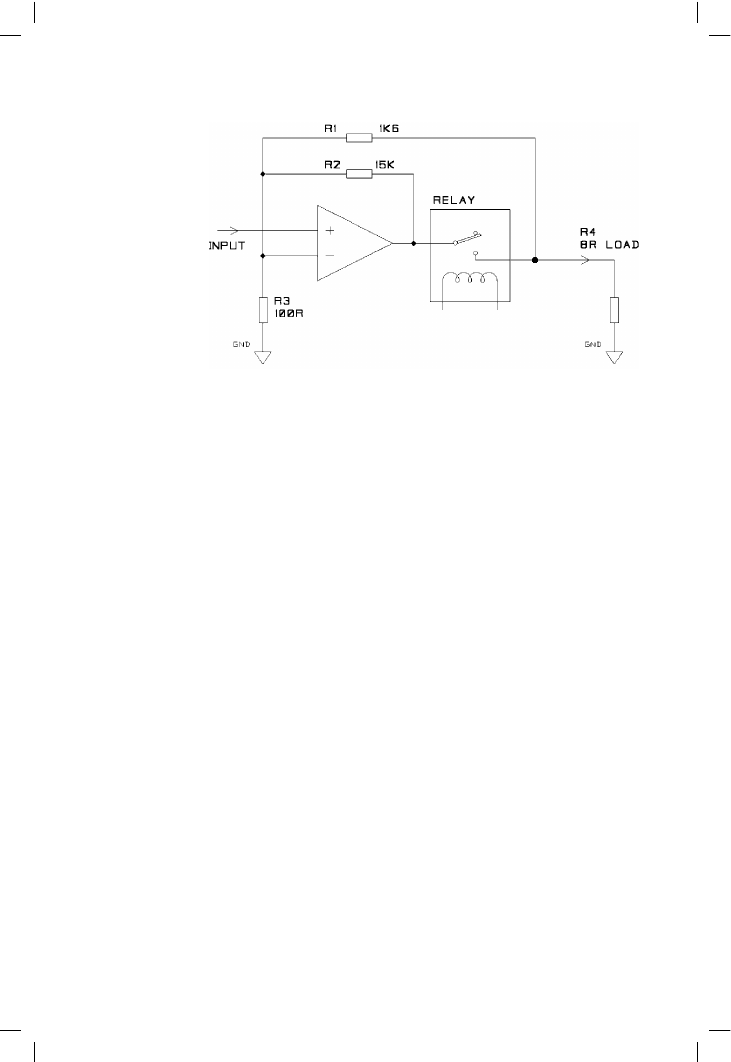ВУЗ: Казахская Национальная Академия Искусств им. Т. Жургенова
Категория: Учебное пособие
Дисциплина: Не указана
Добавлен: 03.02.2019
Просмотров: 17354
Скачиваний: 18

Amplifier and loudspeaker protection
DC protection by fuses
Fuses in series with the output line are sometimes recommended for DC
offset protection, but their only merit is cheapness. It may be true that they
have a slightly better chance of saving expensive loudspeakers than the HT
fuses, but there are at least three snags:
!
Selection of the correct fuse size is not at all easy. If the fuse rating is
small and fast enough to provide some real loudspeaker protection, then
it is likely to be liable to nuisance blowing on large bass transients. A
good visual warning is given by behaviour of the fuse wire; if this can be
seen sagging on transients, then it is going to fail sooner rather than later.
At least one writer on DIY Class-A amplifiers gave up on the problem,
and coolly left the tricky business of fuse selection to the constructor!
!
Fuses running within sight of their nominal rated current generate
distortion at LF due to cyclic changes in their resistance caused by I
2
R
heating; the THD would be expected to rise rapidly as frequency falls,
and Greiner
[6]
states that harmonic and intermodulation distortion near
the burn-out point can reach 4%. It should be possible to eradicate this
by including the fuse inside the global feedback network, for the
distortion will be generated at low frequencies where the feedback
factor is at its greatest, but there are problems with amplifier behaviour
after the fuse has blown.
In my tests, the distortion generated was fairly pure third harmonic. Figure
13.9 shows the THD measured before and after a T1A (slow-blow) fuse in
series with an 8 ! load at 25 W. Below 100 Hz the distortion completely
swamps that produced by the amplifier, reaching 0.007% at 20 Hz. The
distortion rises at rather less than 6 dB/octave as frequency falls. The fuse in
this test is running close to its rating, as increasing the power to 30 W
caused it to blow.
385
Figure 13.9
Fuse distortion. THD
measured before
and after the fuse
at 25 W into 8 !

Audio Power Amplifier Design Handbook
!
Fuses obviously have significant resistance (otherwise they wouldn’t
blow) so putting one in series with the output will degrade the
theoretical damping factor. However, whether this is of any audible
significance is very doubtful.
Note that the HT rail fuses, as opposed to fuses in the output line, are
intended only to minimise amplifier damage in the event of output device
failure. They must not be relied upon for speaker protection against DC
offset faults. Often when one HT fuse is caused to blow the other also does
so, but this cannot be relied upon, and obviously asymmetrical HT fuse
blowing will in itself give rise to a large DC offset.
Relay protection and muting control
Relay protection against DC offsets has the merit that, given careful relay
selection and control-circuitry design, it is virtually foolproof. The relay
should be of the normally-open type so that if the protection fails it will be
to a safe condition.
The first problem is to detect the fault condition as soon as possible. This is
usually done by low-pass filtering the audio output, to remove all signal
frequencies, before the resulting DC level is passed to a comparator that
trips when a set threshold is exceeded. This is commonly in the range of
1–2 V, well outside any possible DC-offsets associated with normal
operation; these will almost certainly be below 100 mV. Any low-pass filter
must introduce some delay between the appearance of the DC fault and the
comparator tripping, but with sensible design this will be too brief to
endanger normal loudspeakers. There are other ways of tackling the fault-
detection problem, for example by detecting when the global negative
feedback has failed, but the filtering approach appears to be the simplest
method and is generally satisfactory. First-order filtering seems to be quite
adequate, though possibly a second-order active filter would give a faster
response time for the same discrimination against false-triggering on bass
transients. In general there is much to be said for keeping protection
circuitry as simple and reliable as possible.
Having paid for a DC protection relay, it seems only sensible to use it for
system muting as well, to prevent thuds and bangs from the upstream parts
of the audio system from reaching the speakers at power-up and power
down. Most power amplifiers, being dual-rail (i.e. DC-coupled) do not
generate enormous thumps themselves, but they cannot be guaranteed to be
completely silent, and will probably produce an audible turn-on thud.
An amplifier relay-control system should:
!
Leave the relay de-energised when muted. At power-up, there should be
a delay of at least 1 second before the relay closes. This can be increased
if required.
386

Amplifier and loudspeaker protection
!
Drop out the relay as fast as is possible at power-down, to stop the dying
moans of the pre-amp, etc. from reaching the outside world.
My preferred technique is a 2 msec (or thereabouts) timer which is held
reset by the AC on the mains transformer secondary, except for a brief
period around the AC zero-crossing, which is not long enough for the
timer to trigger. When the incoming AC disappears, the near-continuous
reset is removed, the timer fires, and the relay is dropped out within
10 msec. This will be long before the various reservoir capacitors in the
system can begin to discharge. However, if the mains switch contacts are
generating RF that is in turn reproduced as a click by the pre-amp, then
even this method may not be fast enough to mute it.
!
Drop out the relay as fast as is possible when a DC offset of more than
1–2 V, in either direction, is detected at the output of either power amp
channel; the exact threshold is not critical. This is normally done by low-
pass filtering the output (47k and 47 µF works OK) and applying it to
some sort of absolute-value circuit to detect offsets in either direction.
The resulting signal is then OR-ed in some way with the muting signal
mentioned above.
!
Don’t forget that the contacts of a relay have a much lower current rating
for breaking DC rather than AC. This is an issue that doesn’t seem to
have attracted the attention it deserves.
A block diagram of a relay control system meeting the above requirements
is shown in Figure 13.10, which includes over-temperature protection. Any
of the three inhibit signals can override the turn-on delay and pull out the
relay.
387
Figure 13.10
Output relay control
combining DC offset
protection and power-
on/off muting

Audio Power Amplifier Design Handbook
388
Distortion in output relays
Relays remain the only simple and effective method of disconnecting an
amplifier from its load. The contacts can carry substantial currents, and it
has been questioned whether they can introduce non-linearities.
My experience is that silver-based contacts in good condition show
effectively perfect linearity. Take a typical relay intended by its manu-
facturer for output-switching applications, with ‘silver alloy’ contacts –
whatever that means – rated at 10 A. Figure 13.11 shows THD before and
after the relay contacts while driving an 8 ! load to 91 W, giving a current
of 3.4 A rms. There is no significant difference; the only reason that the lines
do not fall exactly on top of each other is because of the minor bias changes
that Class B is heir to. This apparently perfect linearity can be badly
degraded if the contacts have been maltreated by allowing severe arcing –
typically while trying and failing to break a severe DC fault.
Not everyone is convinced of this. If the contacts were non-linear for
whatever reason, an effective way of dealing with it would be to include
them in the amplifier feedback loop, as shown in Figure 13.12. R1 is the
main feedback resistor, and R2 is a subsidiary feedback path that remains
closed when the relay contacts open, and hopefully prevents the amplifier
from going completely berserk. With the values shown the normal gain is
15.4 times, and with the contacts open it is 151 times. There is a feedback
factor of about ten to linearise any relay problems.
Figure 13.11
Demonstrating that
relay contacts in
themselves are
completely distortion-
free. Current through
contacts was
3.4 A rms

Amplifier and loudspeaker protection
The problem of course is that if there is to be a healthy amount of NFB
wrapped around the relay contacts, R2 must be fairly high and so the
closed-loop gain shoots up. If there is still an input signal, then the amplifier
will be driven heavily into clipping. Some designs object to this, but even
if the amplifier does not fail it is likely to accumulate various DC offsets on
its internal time-constants as a result of heavy clipping, and these could
cause unwanted noises when the relay contacts close again. One solution
to this is a muting circuit at the amplifier input that removes the signal
entirely and prevents clipping. This need not be a sophisticated circuit, as
huge amounts of muting are not required; –40 dB should be enough. It
must, however, pass the signal cleanly when not muting.
A much more insidious – unexpected – form of non-linearity can occur if
the relay is constructed so that its frame makes up part of the switched
electrical circuit as well as the magnetic circuit. (This is not the case with
the audio application relay discussed above.) A relay frame is made of soft
iron, to prevent it becoming permanently magnetised, and this appears to
present a non-linear resistance to a loudspeaker level signal, presumably
due to magnetisation and saturation of the material. (It should be said at
once that this is described by the manufacturer as a ‘power relay’ and is
apparently not intended for audio use.) A typical example of this
construction has massive contacts of silver/cadmium oxide, rated at 30 A
AC, which in themselves are linear. However, used as an amplifier output
relay, this component generates more – much more – distortion than the
power amplifier it is associated with.
The effect increases with increasing current; 4.0 A rms passing through the
relay gives 0.0033% THD and 10 A rms gives 0.018%. The distortion level
appears to increase with the square of the current. Experiment showed that
the distortion was worst where the frame width was narrowest, and hence
the current density greatest.
389
Figure 13.12
How to enclose relay
contacts in the
feedback loop. The
gain shoots up when
the relay contacts
open, so muting the
input signal is
desirable